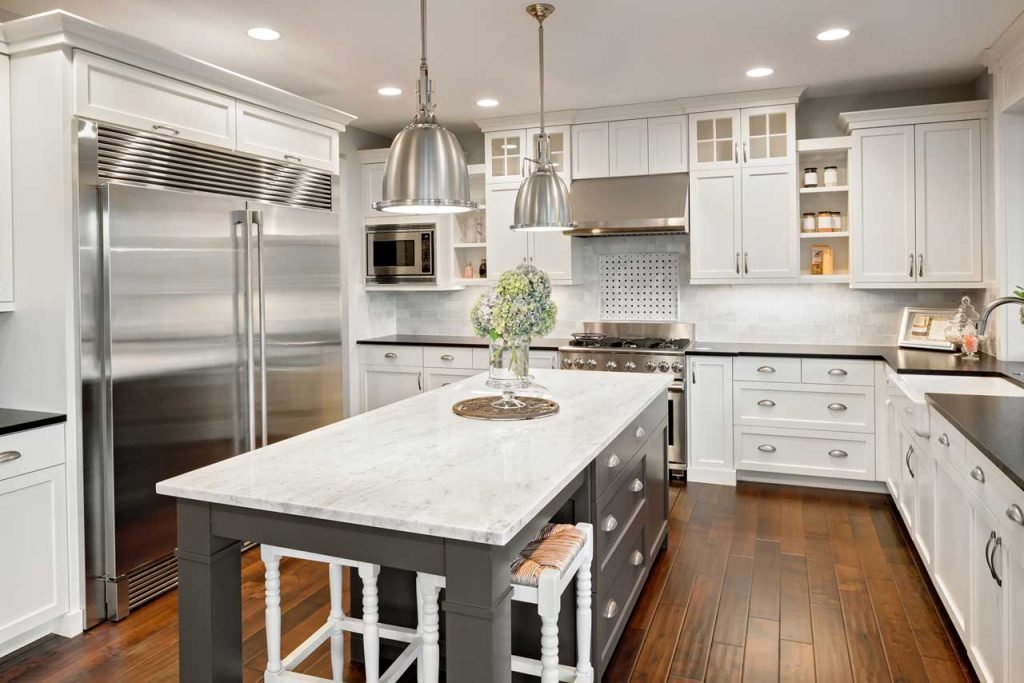One of the core elements of a new shaker kitchen is the materials. Finding the best materials for your kitchen is essential for creating a space that is both functional and stylish. There is a wealth of materials to choose from. In this article, we take a look at the central elements of kitchen design, along with the types of materials that make them.
Things to Consider
With the rise of open plan kitchens and kitchen diners, our kitchens are no longer hidden away from guests. Instead, they are spaces we can share with guests and visitors. This emphasis on open plan means that design has never been more important, as everything is on display.
Before considering your materials, spare some time to determine the character and style you want for your kitchen. These will help inform your choices. A warmer, more traditional feel lends itself more to natural materials such as wood and stone. While a more contemporary, minimalist approach demands more modern materials. Your colour scheme, furniture and accessories will also play a part in determining your chosen style.
When it comes to kitchens, utility and style must go hand in hand. Your kitchen should suit your lifestyle and needs. When making any decision, ask whether it truly works for you. The last thing you want is a stylish kitchen that doesn’t meet your requirements.

Kitchen Worktops
Worktops are one of the most important features of the kitchen. Depending on your kitchen design budget, you’ll have an abundance of choice when it comes to materials. Worktop materials should be hard wearing and durable, able to withstand daily use while never losing their aesthetic appeal.
For a high end kitchen, many renovators are choosing luxe materials, such as marble, for sleek, sturdy counter tops. Getting the high end look however, doesn’t necessarily mean costly materials. Other popular and equally stylish materials include granite, wood and laminate.
A recent trend sweeping kitchen showrooms is to mix and match worktops, using different materials depending on the area’s purpose. For example, in the more hard working areas, such as food preparation, more expensive materials are worthwhile as they will undoubtedly provide greater resistance to spills, scratches and scorches.
Keep in mind the layout of your kitchen when choosing materials. For straight cut work surfaces that are simpler to install, you might opt for more high end materials. While surfaces with plenty of corners and cut outs are more complex to fit and thus will be more expensive, which might cause you to reconsider your choice of material.
Below are some of the most popular kitchen worktop materials:
Wood
Adding character and warmth to the kitchen, hardwood worktops are strong and sturdy, making them ideal for food preparation and dining areas. Provided they are properly maintained, they are extremely durable.
Quartz
Strong and non porous, quartz worktops and scratch, stain and scorch resistant. This makes them suitable for areas such as around the hob and sink. Incredibly durable, quartz worktops are also very low maintenance.
Granite
A more luxury material, granite is sleek, hard wearing and water and heat resistant. Another low maintenance worktop material that is designed to last, it is important to ensure spills from acidic substances such as wine and citrus are properly cleaned to protect the surface.
Laminate
Laminate offers a wide range of choice for colour, pattern and style. Not only is it low maintenance, water and scratch resistant, but it is also quick and simple to install. This flexible material can even be styled to look and feel like more expensive materials such as granite or marble.
Kitchen Cabinets
When it comes to kitchen renovation, cabinets are the largest cost. Unsurprising as they are typically the first thing people see. Therefore, it’s important to get them right, by choosing the correct material.
Wood is the obvious choice for cabinets (although some designers have opted for stainless steel). While solid wood seems like the best material, many designers are turning toward engineered wood, as solid wood tends to expand and contract, particularly where moisture is present. MDF is popular due to its smooth surface and resistance to cracking, making it easier to paint. However, plywood is also common due to its stability and excellent moisture resistance.
Depending on your style preferences, popular wood types for cabinets include maple for its smooth grain and versatility, cherry for its classic look and availability, and oak for its distinctive grain and traditional style.

